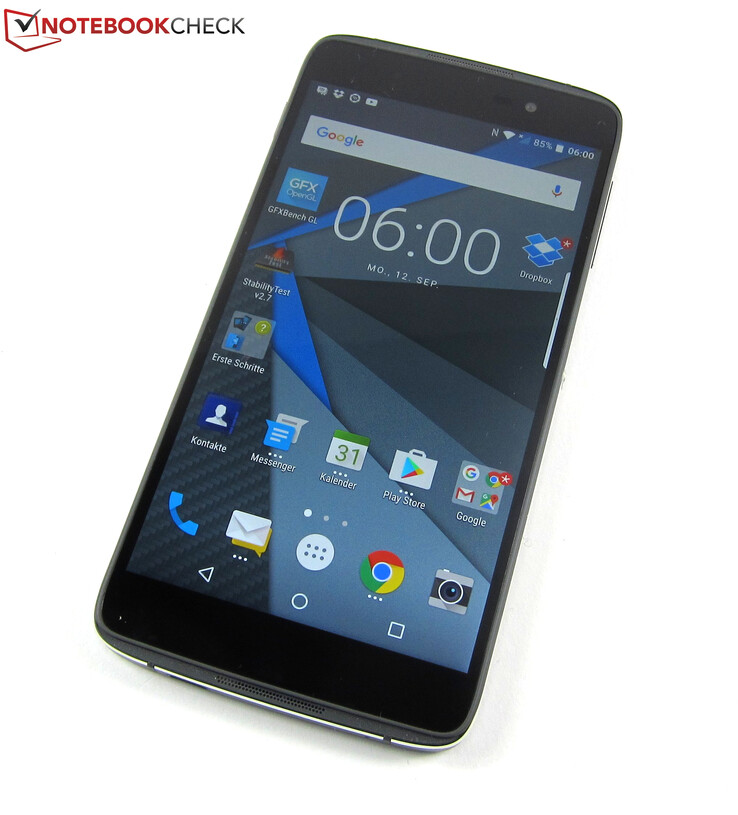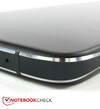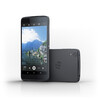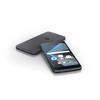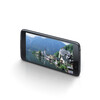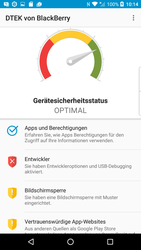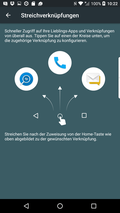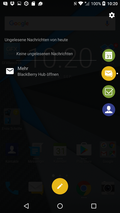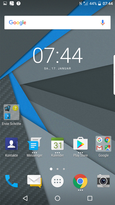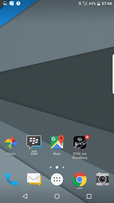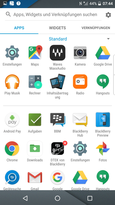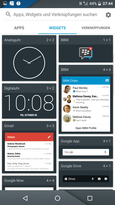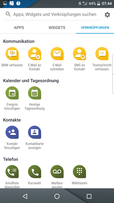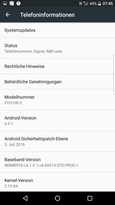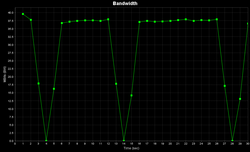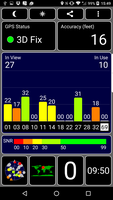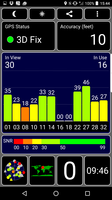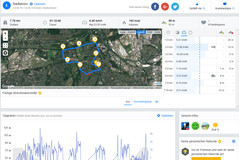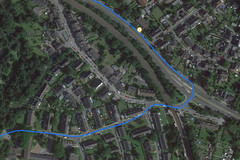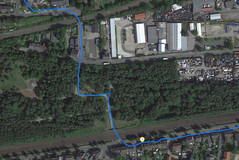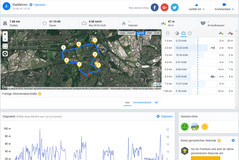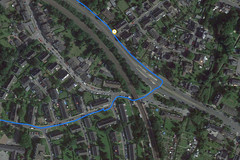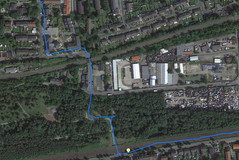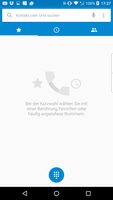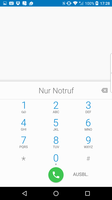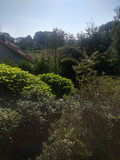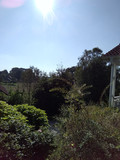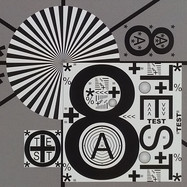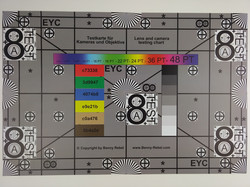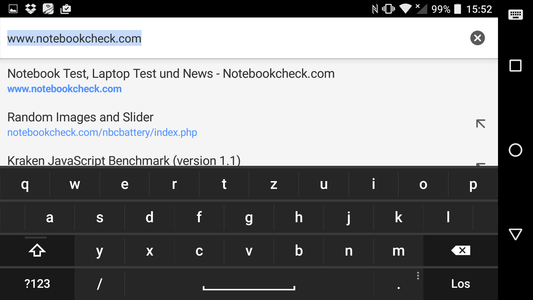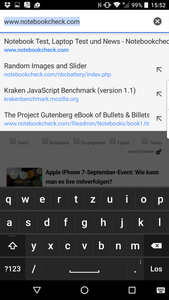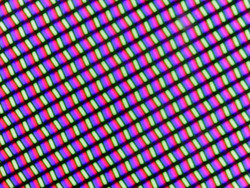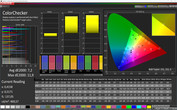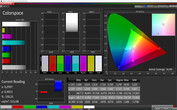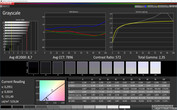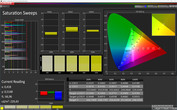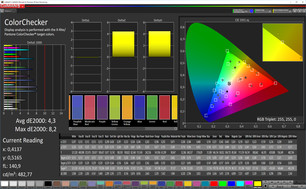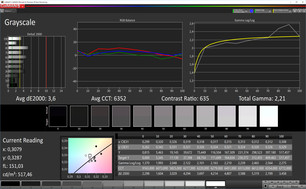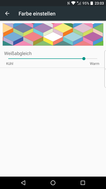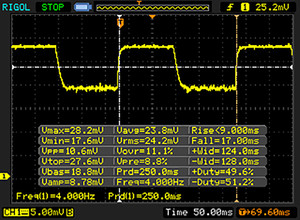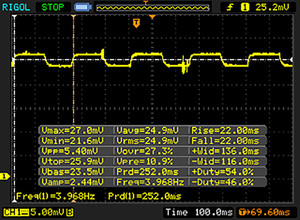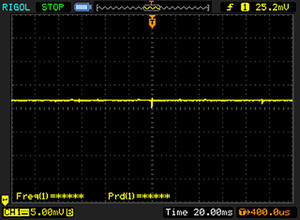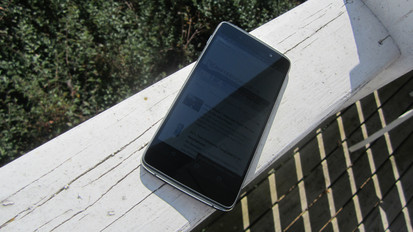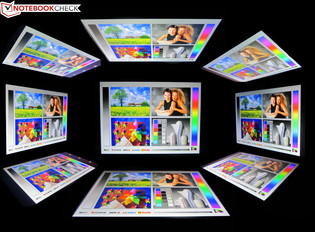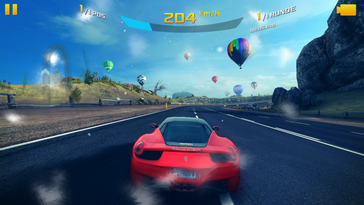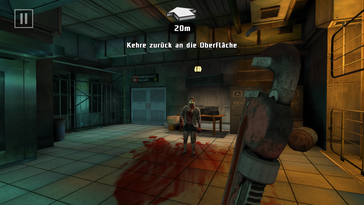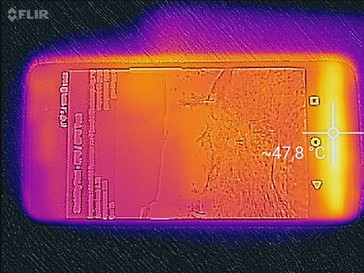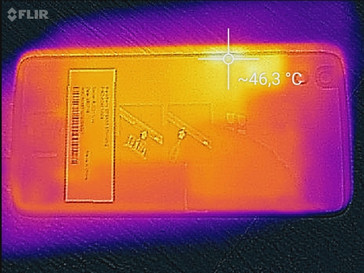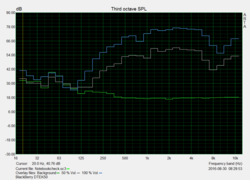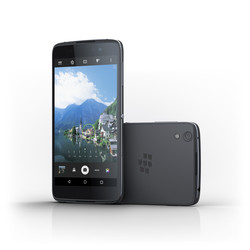BlackBerry DTEK50 Smartphone Review
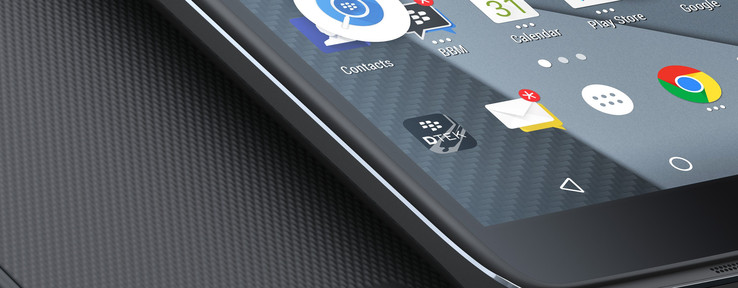
For the original German review, see here.
Android and security – apparently, both are not quite compatible at the moment. It seems that in ever decreasing shorter periods, reports of security vulnerabilities in Google OS are being identified that hackers and cyber criminals can use to the detriment of the smartphone's user. The list of cruelties ranges from stealing online banking access data up to smartphone lock screens that only disappear after paying a Bitcoin ransom. BlackBerry's 5.2-inch DTEK50 comes right on cue.
According to the manufacturer, he DTEK50 is nothing less than the most secure Android smartphone in the world. BlackBerry has the right to boast with this, since its proprietary and homonymous operating system impresses with a particularly high security level. Android is now also benefiting from this. BlackBerry has supplemented the Android 6.0 Marshmallow preloaded on the DTEK50 by countless security features, making it almost as safe as BlackBerry OS - more about this in the "Software" section.
Viewed objectively, BlackBerry DTEK50 is a mid-range smartphone that does not provide very spectacular hardware features - its highlight is definitely its software. The buyer gets a smartphone with a Full HD panel, 3 GB of RAM, and 16 GB of storage for around 300 Euros (~$337). A Qualcomm Snapdragon 617 MSM8952 octa-core processor, LTE radio, and cameras with resolutions of 8 and 13 megapixels are also part of the package. The DTEK50 competes against rivals with a similar configuration - namely, Acer's Liquid Jade Primo, HTC's One A9, Lenovo's Moto G4 Plus, and Samsung' Galaxy A5 (2016).
Case
BlackBerry has encased the DTEK50 in a plastic casing that is framed by a metal bezel. The combination of the scratch-resistant glass that covers almost the entire front, and its rounded corners and edges contribute to the relatively high-quality impression of the smartphone. The textured back does not look quite as stylish, but its rubber coating provides the fingers with good grip. With a height of 7.4 millimeters (~0.3 in), the DTEK50 is BlackBerry's slimmest handset. With a weight of 135 grams (~5 oz), it is also pleasantly light.
A so-called "Convenience" button that can be initially confused with the left-handed power button is located on the smartphone's right. The Convenience button allows quick access to apps and functions, and can be mapped individually. The dual slot for a nano-SIM and micro-SD card is directly beside it. The stereo speakers are on the short sides above and below the display.
Connectivity
The Qualcomm's Snapdragon 617 MSM8952 in the DTEK50 is an octa-core processor based on Cortex A53 with mid-range performance. Qualcomm's Adreno 405 graphics chip and 3 GB of RAM support the CPU. Thus, it definitely has enough power for Android applications. However, games with high graphic requirements will only tend to run smoothly in lower detail levels.
The smartphone's storage configuration is also meager. The flash memory with a nominal capacity of 16 GB is reduced to almost 9 GB by Android and the preloaded apps in use. However, the capacity can be expanded flexibly via the micro-SD slot (theoretically a max. of 2 TB) and the card can be used as either a removable memory or as an internal memory. Moving compatible apps to the micro-SD card (App2SD) is also possible.
Unfortunately, a fingerprint scanner is not included. It would have been taken for granted when the manufacturer speaks of the most secure Android smartphone.
| SD Card Reader | |
| maximum SDCardreader Maximum Transfer Rate | |
| average SDCardreader Average Transfer Rate |
Software
The latest Android 6.0 Marshmallow runs on the DTEK50. BlackBerry has carefully modified the OS according to its security concept, and thus not much software is preloaded. Nothing has been modified excessively so that Android users will easily cope with BlackBerry's version. However, we struggled with some incompatibilities during the test, which are probably due to BlackBerry's revisions of the operating system. For example, the GFXBench and Geekbench benchmarks did not run. We could not determine any exact gaming benchmarks using GameBench in the gaming benchmarks since the smartphone was not recognized.
As the Smartphone’s name indicates, the heart piece of the software is the app "DTEK" that monitors the handset's security status. Among other things, it monitors which app has which access rights and can, when desired, withdraw them. Furthermore, it checks the system's integrity level and provides recommendations on how to make the smartphone even safer. Android 6.0 supports the functions of DTEK, but the user can directly access the corresponding system settings and does not have to awkwardly scroll through various menus with BlackBerry's app. However, the app has a drawback: Since DTEK permanently scans the system in the background, some performance is lost. This was noticed in our benchmark course where BlackBerry's DTEK50 performed slightly worse than smartphones based on the same SoC.
The notification center, "BlackBerry Hub", in particular stands out from the other preloaded applications such as the encrypted messaging service "BlackBerry Messenger" and data locker "BlackBerry Password Safe". The handy tool is a central inbox for emails, calendar entries, and notifications from social networks and calls. It is also possible to scan the Hub and filter according to diverse criteria.
The slide-in bar on the screen's center right edge integrated into BlackBerry's Android also provides a lot of overview. It is enabled by swiping, and it then displays new calendar entries, emails, tasks, and contacts. A convenient feature is also the swipe shortcuts that allow opening up to three apps. Depending on the app, the user only has to swipe left or right in a curve or straight up from the home button - applications cannot be opened any faster. The Convenience button, which triggers a predefined action, such as launching an app such as Google Chrome, completes the productivity features.
The biggest modification compared with a standard Android system is found under the hood. In addition to DTEK as a software watchdog, other security mechanisms such as encrypting all data on the smartphone are also present. The handset also checks whether the operating system or bootloader has been tampered with. The DTEK50 cannot be rooted and only accepts a manufacturer-signed bootloader. The DTEK50 only executes BlackBerry-signed system programs and utilizes Address Space Layout Randomization (ASLR) for preventing codes from infiltrating the system.
An additional security component is the speed at which BlackBerry provides system updates. According to BlackBerry, it is much faster than the competition. The security updates launched in early August 2016 for BlackBerry's Priv and DTEK50 smartphones prove that this is not an empty promise. The patch was released two days after the discovery of a "QuadRooter" security vulnerability that affected both devices.
Communication and GPS
The DTEK50 is well-equipped in terms of communication technologies. GSM quad-band (850, 900, 1800, 1900 MHz), UMTS quad-band (850, 900, 1900, 2100 MHz), and LTE 1, 2, 3, 7, 8, 20, 28A, 38, 40, 41 enables using the smartphone for telephoning and accessing the Internet from almost anywhere in Germany. The manufacturer does not specify maximum upload or download speeds.
The Wi-Fi module supports all the current standards up to 802.11ac, but only in 2.4 GHz networks at the time of testing although nominally, transmitting in 5.0 GHz networks is supported. The transfer rates determined a meter (~3 ft) away from our Linksys EA8500 reference router can only be called abysmal. With 37.3 MBit/s in receiving data, the DTEK50 is far behind its opponents. It looks even worse in server mode with an unacceptable 29.4 MBit/s. Acer's Liquid Jade Primo shows how the job is done properly with transfer rates of up to 551 MBit/s in the 5 GHz network.
| Networking | |
| iperf Server (receive) TCP 1 m | |
| Acer Liquid Jade Primo | |
| BlackBerry DTEK50 | |
| iperf Client (transmit) TCP 1 m | |
| Acer Liquid Jade Primo | |
| BlackBerry DTEK50 | |
BlackBerry's DTEK50 utilizes GPS for tracking its current position, which also functioned well in the test. The smartphone located us with an accuracy of a few meters indoors and outside. That is a good precondition for our bike trip where both the DTEK50 and Garmin's Edge 500 professional navigation system guided us to our destination. As expected, Garmin's device achieved the higher accuracy at the end of the roughly 8-kilometer (~5 mi) test route, but BlackBerry's smartphone kept up quite well. It sometimes placed us beside the route or took some sharp bends, but the app is accurate enough for everyday use.
Telephone and Call Quality
BlackBerry's DTEK50 convinced us with its high voice quality during calls in the test - regardless of whether via the landline or via the mobile network. The stereo speakers and the included in-ear headset also do a good job. Even hands-free mode functioned smoothly, although the background noises naturally could not be completely cancelled. BlackBerry relies on the standard Android phone app design, including standard functions such as call lists, keypad, favorites, and direct access to contacts.
Cameras
BlackBerry's DTEK50 is equipped with two cameras: The front facing 8-megapixel camera features an LED flash and face recognition and shoots photos up to a size of 3264x2488 pixels and records videos in either 720p or 1080p resolution at 24, 30 or 60 frames per second. The 13-megapixel primary camera on the back has the same video settings in common (maximum: 4160x3120 pixels), but it also features autofocus. Both cameras have an HDR and a timer function in addition to various color effects such as sepia or negative that can be turned on and off. The f-number can also be adjusted in each case.
Both cameras achieve a decent image quality, but they are not real photo artists. Furthermore, image noise develops quite fast in photos and video recordings in unfavorable light conditions.
In addition to our test snapshots, we check the sharpness and colors under controlled test conditions. We photograph ColorChecker Passport and our test chart full-frame. The photos are not edited afterwards. The DTEK50 reproduces colors a bit too strongly while it is the opposite in the grayscale levels. The test chart photo is slightly sharper, but with very visible image noise. To be fair, it must be said that this is really only seen at 100% magnification.
Accessories and Warranty
BlackBerry includes a modular power supply, USB cable, an in-ear headset, and a quick-start guide for the DTEK50. The manufacturer offers various accessories for its smartphone in its online shop, such as a flip case and holster for 35 Euros (~$39) each or a mobile power bank for 60 Euros (~67). The end consumer receives a 2-year warranty on the DTEK50 depending on region.
Input Devices and Handling
Powered by Qualcomm's Snapdragon 617 MSM8952 octa-core SoC, the handling of BlackBerry's DTEK50 is pleasantly smooth. The smartphone implements inputs via its touchscreen accurately even in the corners, and the smartphone also rotates the contents in the right direction without noticeable lags. Some waiting time is needed only during booting, which takes approximately 50 seconds.
Display
The screen in BlackBerry's DTEK50 has a resolution of 1920x1080 pixels, which leads to a pixel density of 424 PPI. The manufacturer states that the screen is scratch-resistant, but we did not test this. The smartphone offers plenty of brightness reserves with an average of 511.4 cd/m², and is only surpassed by Lenovo's Moto G4 Plus among the comparison devices. The black level of 0.89 cd/m² and the resulting contrast ratio of 601.1 are not exceptional rates. This is not noticeable during use since the DTEK50 impresses with bright colors and crisp contrasts.
| |||||||||||||||||||||||||
Brightness Distribution: 89 %
Center on Battery: 535 cd/m²
Contrast: 601:1 (Black: 0.89 cd/m²)
ΔE ColorChecker Calman: 4.3 | ∀{0.5-29.43 Ø4.78}
ΔE Greyscale Calman: 3.6 | ∀{0.09-98 Ø5}
Gamma: 2.21
CCT: 6352 K
| BlackBerry DTEK50 IPS, 1920x1080, 5.2" | Acer Liquid Jade Primo AMOLED, 1920x1080, 5.5" | HTC One A9 AMOLED, 1920x1080, 5" | Lenovo Moto G4 Plus IPS, 1920x1080, 5.5" | Samsung Galaxy A5 2016 Super AMOLED, 1920x1080, 5.2" | |
|---|---|---|---|---|---|
| Screen | 1% | 9% | 18% | 19% | |
| Brightness middle (cd/m²) | 535 | 355 -34% | 346 -35% | 609 14% | 378 -29% |
| Brightness (cd/m²) | 511 | 356 -30% | 349 -32% | 589 15% | 380 -26% |
| Brightness Distribution (%) | 89 | 88 -1% | 93 4% | 87 -2% | 91 2% |
| Black Level * (cd/m²) | 0.89 | 0.63 29% | |||
| Contrast (:1) | 601 | 967 61% | |||
| Colorchecker dE 2000 * | 4.3 | 2.9 33% | 1.55 64% | 3.8 12% | 1.95 55% |
| Colorchecker dE 2000 max. * | 8.2 | 10.5 -28% | 8.3 -1% | 3.09 62% | |
| Greyscale dE 2000 * | 3.6 | 1.2 67% | 2.05 43% | 3.1 14% | 1.86 48% |
| Gamma | 2.21 100% | 2.26 97% | 2.15 102% | 2.06 107% | 2.13 103% |
| CCT | 6352 102% | 6381 102% | 6267 104% | 6725 97% | 6376 102% |
* ... smaller is better
Our measurements with Colorimeter's X-Rite i1pro 2 and CalMAN software show that BlackBerry has not calibrated the smartphone's screen very accurately. The color temperature of 7896 K is clearly higher than the ideal rate of 6500 K, which leads to a cool color reproduction. The shift in the color reproduction (DeltaE: 7.2) and grayscale reproduction (DeltaE: 8.7) are also relatively high.
Despite that, the DTEK50 manages to save itself. The color temperature can be adjusted manually in the settings (see right screenshot above), which resulted in visibly improved image parameters. The color temperature then settled to a good 6352 K and the DeltaE rates dropped to a decent 4.3 in colors and 3.6 in grayscale levels.
Display Response Times
| ↔ Response Time Black to White | ||
|---|---|---|
| 26 ms ... rise ↗ and fall ↘ combined | ↗ 9 ms rise | |
| ↘ 17 ms fall | ||
| The screen shows relatively slow response rates in our tests and may be too slow for gamers. In comparison, all tested devices range from 0.1 (minimum) to 240 (maximum) ms. » 61 % of all devices are better. This means that the measured response time is worse than the average of all tested devices (20.2 ms). | ||
| ↔ Response Time 50% Grey to 80% Grey | ||
| 44 ms ... rise ↗ and fall ↘ combined | ↗ 22 ms rise | |
| ↘ 22 ms fall | ||
| The screen shows slow response rates in our tests and will be unsatisfactory for gamers. In comparison, all tested devices range from 0.165 (minimum) to 636 (maximum) ms. » 72 % of all devices are better. This means that the measured response time is worse than the average of all tested devices (31.7 ms). | ||
Screen Flickering / PWM (Pulse-Width Modulation)
| Screen flickering / PWM not detected | |||
In comparison: 53 % of all tested devices do not use PWM to dim the display. If PWM was detected, an average of 8142 (minimum: 5 - maximum: 343500) Hz was measured. | |||
BlackBerry's DTEK50 has a high viewing angle stability thanks to its IPS panel. The screen remains impeccably legible without darkening or brightening significantly even from extreme lateral views. The smartphone's brightness of 511 cd/m² is more than sufficient for outdoor use. Only the glossy screen might sometimes prevent a clear view of the contents.
Performance
Qualcomm's Snapdragon 617 MSM8952 64-bit capable mid-range SoC can utilize eight Cortex A53 cores that clock at up to 1.5 GHz each. Qualcomm's Adreno 405 is responsible for graphic calculations.
Although BlackBerry's DTEK50 stays slightly behind HTC's One A9 and Lenovo's Moto G4 Plus, it is roughly on par with these handsets in the synthetic benchmarks. We presume that the DTEK security app is responsible for this to a certain degree since it permanently scans the system in the background. Subjectively, applications launch quickly, run smoothly, and nothing stutters during use. GFXBench and Geekbench started on BlackBerry's DTEK50, but either they did not find the provider's server (GFXBench) or aborted the test with an error message (Geekbench).
| AnTuTu v6 - Total Score (sort by value) | |
| BlackBerry DTEK50 | |
| Acer Liquid Jade Primo | |
| Lenovo Moto G4 Plus | |
| Samsung Galaxy A5 2016 | |
| Geekbench 3 | |
| 64 Bit Single-Core Score (sort by value) | |
| HTC One A9 | |
| Lenovo Moto G4 Plus | |
| 64 Bit Multi-Core Score (sort by value) | |
| HTC One A9 | |
| Lenovo Moto G4 Plus | |
| 3DMark | |
| 1280x720 offscreen Ice Storm Unlimited Score (sort by value) | |
| HTC One A9 | |
| Lenovo Moto G4 Plus | |
| Samsung Galaxy A5 2016 | |
| 1280x720 offscreen Ice Storm Unlimited Graphics Score (sort by value) | |
| HTC One A9 | |
| Lenovo Moto G4 Plus | |
| Samsung Galaxy A5 2016 | |
| 1280x720 offscreen Ice Storm Unlimited Physics (sort by value) | |
| HTC One A9 | |
| Lenovo Moto G4 Plus | |
| Samsung Galaxy A5 2016 | |
| 2560x1440 Sling Shot OpenGL ES 3.0 (sort by value) | |
| BlackBerry DTEK50 | |
| HTC One A9 | |
| Lenovo Moto G4 Plus | |
| Samsung Galaxy A5 2016 | |
| 2560x1440 Sling Shot OpenGL ES 3.0 Graphics (sort by value) | |
| BlackBerry DTEK50 | |
| HTC One A9 | |
| Lenovo Moto G4 Plus | |
| Samsung Galaxy A5 2016 | |
| 2560x1440 Sling Shot OpenGL ES 3.0 Physics (sort by value) | |
| BlackBerry DTEK50 | |
| HTC One A9 | |
| Lenovo Moto G4 Plus | |
| Samsung Galaxy A5 2016 | |
| GFXBench (DX / GLBenchmark) 2.7 | |
| T-Rex Onscreen (sort by value) | |
| Acer Liquid Jade Primo | |
| HTC One A9 | |
| Lenovo Moto G4 Plus | |
| Samsung Galaxy A5 2016 | |
| 1920x1080 T-Rex Offscreen (sort by value) | |
| Acer Liquid Jade Primo | |
| HTC One A9 | |
| Lenovo Moto G4 Plus | |
| Samsung Galaxy A5 2016 | |
| GFXBench 3.0 | |
| on screen Manhattan Onscreen OGL (sort by value) | |
| Acer Liquid Jade Primo | |
| HTC One A9 | |
| Lenovo Moto G4 Plus | |
| Samsung Galaxy A5 2016 | |
| 1920x1080 1080p Manhattan Offscreen (sort by value) | |
| Acer Liquid Jade Primo | |
| HTC One A9 | |
| Lenovo Moto G4 Plus | |
| Samsung Galaxy A5 2016 | |
| GFXBench 3.1 | |
| on screen Manhattan ES 3.1 Onscreen (sort by value) | |
| HTC One A9 | |
| Lenovo Moto G4 Plus | |
| 1920x1080 Manhattan ES 3.1 Offscreen (sort by value) | |
| HTC One A9 | |
| Lenovo Moto G4 Plus | |
| PCMark for Android - Work performance score (sort by value) | |
| BlackBerry DTEK50 | |
| HTC One A9 | |
| Lenovo Moto G4 Plus | |
| Samsung Galaxy A5 2016 | |
It is almost a tie in the browser benchmarks. Overall, the DTEK50 finished the test just as fast as HTC's One A9, Lenovo's Moto G4 Plus, and Samsung's Galaxy A5 (2016). However, the four handsets did not stand a chance against Acer's Liquid Jade Primo in Google Octane 2.0 and Mozilla Kraken 1.1.
| Octane V2 - Total Score (sort by value) | |
| BlackBerry DTEK50 | |
| Acer Liquid Jade Primo | |
| HTC One A9 | |
| Lenovo Moto G4 Plus | |
| Samsung Galaxy A5 2016 | |
| Mozilla Kraken 1.1 - Total (sort by value) | |
| BlackBerry DTEK50 | |
| Acer Liquid Jade Primo | |
| HTC One A9 | |
| Lenovo Moto G4 Plus | |
| Samsung Galaxy A5 2016 | |
| WebXPRT 2015 - Overall (sort by value) | |
| BlackBerry DTEK50 | |
| HTC One A9 | |
| Lenovo Moto G4 Plus | |
| Samsung Galaxy A5 2016 | |
| JetStream 1.1 - Total Score (sort by value) | |
| BlackBerry DTEK50 | |
| Acer Liquid Jade Primo | |
| HTC One A9 | |
| Lenovo Moto G4 Plus | |
| Samsung Galaxy A5 2016 | |
* ... smaller is better
The DTEK50 performs read and write operations quickly. The smartphone also does a good job in read and write tasks with the micro-SD card. Although it cannot fully utilize the Toshiba Exceria Pro M401 reference card (read: max. 95 MB/s; write: max. 80 MB/s), it achieves decent rates.
| AndroBench 3-5 | |
| Sequential Read 256KB (sort by value) | |
| BlackBerry DTEK50 | |
| HTC One A9 | |
| Lenovo Moto G4 Plus | |
| Samsung Galaxy A5 2016 | |
| Sequential Write 256KB (sort by value) | |
| BlackBerry DTEK50 | |
| HTC One A9 | |
| Lenovo Moto G4 Plus | |
| Samsung Galaxy A5 2016 | |
| Random Read 4KB (sort by value) | |
| BlackBerry DTEK50 | |
| HTC One A9 | |
| Lenovo Moto G4 Plus | |
| Samsung Galaxy A5 2016 | |
| Random Write 4KB (sort by value) | |
| BlackBerry DTEK50 | |
| HTC One A9 | |
| Lenovo Moto G4 Plus | |
| Samsung Galaxy A5 2016 | |
| Sequential Read 256KB SDCard (sort by value) | |
| BlackBerry DTEK50 | |
| Lenovo Moto G4 Plus | |
| Sequential Write 256KB SDCard (sort by value) | |
| BlackBerry DTEK50 | |
| Lenovo Moto G4 Plus | |
Games
In theory, Qualcomm's Adreno 405 graphics chip has enough power for up-to-date Android games. Graphically demanding games, such as "Asphalt 8" or "Dead Trigger 2" can still run in high detail but are tough on the limits of smooth running and are slightly jerky. Basic games with lower graphic requirements, such as "Angry Birds 2", are no problem for the DTEK50.
Emissions
Temperature
For a restrained handset, BlackBerry's DTEK50 is hot-tempered during use. It heats up just as strongly in idle as other smartphones during full load with an average of 35.4 °C (~96 °F) on the upper side and underside. When the DTEK50 is put under full load, the temperatures climb up to 45.9 °C (~115 °F). The smartphone is then rather unpleasant to hold for prolonged periods. Unfortunately, we cannot provide the usual GFXBench battery test at this point since BlackBerry's DTEK50 absolutely refused to run it.
(-) The maximum temperature on the upper side is 45.9 °C / 115 F, compared to the average of 35.2 °C / 95 F, ranging from 21.9 to 247 °C for the class Smartphone.
(±) The bottom heats up to a maximum of 43.4 °C / 110 F, compared to the average of 34 °C / 93 F
(±) In idle usage, the average temperature for the upper side is 36.2 °C / 97 F, compared to the device average of 32.9 °C / 91 F.
Speakers
The stereo speakers hidden in the DTEK50's casing produce a strong sound at up to 86 dB(A) without distorting. As expected from the little smartphone speakers, high tones dominate, while mids are virtually non-existent and low tones are hinted at best. In any case, the quality is enough for playing YouTube videos and music files.
BlackBerry DTEK50 audio analysis
(+) | speakers can play relatively loud (86 dB)
Bass 100 - 315 Hz
(-) | nearly no bass - on average 23.7% lower than median
(±) | linearity of bass is average (12.8% delta to prev. frequency)
Mids 400 - 2000 Hz
(+) | balanced mids - only 4.7% away from median
(+) | mids are linear (6.5% delta to prev. frequency)
Highs 2 - 16 kHz
(±) | higher highs - on average 7.7% higher than median
(+) | highs are linear (6.5% delta to prev. frequency)
Overall 100 - 16.000 Hz
(±) | linearity of overall sound is average (20.9% difference to median)
Compared to same class
» 38% of all tested devices in this class were better, 8% similar, 54% worse
» The best had a delta of 11%, average was 35%, worst was 134%
Compared to all devices tested
» 56% of all tested devices were better, 8% similar, 37% worse
» The best had a delta of 4%, average was 24%, worst was 134%
Acer Liquid Jade Primo audio analysis
(+) | speakers can play relatively loud (87.2 dB)
Bass 100 - 315 Hz
(-) | nearly no bass - on average 39.3% lower than median
(+) | bass is linear (6.4% delta to prev. frequency)
Mids 400 - 2000 Hz
(±) | reduced mids - on average 6.9% lower than median
(±) | linearity of mids is average (8.1% delta to prev. frequency)
Highs 2 - 16 kHz
(+) | balanced highs - only 3.5% away from median
(+) | highs are linear (3.8% delta to prev. frequency)
Overall 100 - 16.000 Hz
(±) | linearity of overall sound is average (24.7% difference to median)
Compared to same class
» 59% of all tested devices in this class were better, 7% similar, 34% worse
» The best had a delta of 11%, average was 35%, worst was 134%
Compared to all devices tested
» 74% of all tested devices were better, 6% similar, 20% worse
» The best had a delta of 4%, average was 24%, worst was 134%
Samsung Galaxy A5 2016 audio analysis
(+) | speakers can play relatively loud (87.7 dB)
Bass 100 - 315 Hz
(-) | nearly no bass - on average 33.7% lower than median
(±) | linearity of bass is average (11.1% delta to prev. frequency)
Mids 400 - 2000 Hz
(+) | balanced mids - only 4.2% away from median
(+) | mids are linear (5.4% delta to prev. frequency)
Highs 2 - 16 kHz
(+) | balanced highs - only 4.7% away from median
(±) | linearity of highs is average (8.4% delta to prev. frequency)
Overall 100 - 16.000 Hz
(±) | linearity of overall sound is average (22.1% difference to median)
Compared to same class
» 45% of all tested devices in this class were better, 7% similar, 48% worse
» The best had a delta of 11%, average was 35%, worst was 134%
Compared to all devices tested
» 63% of all tested devices were better, 6% similar, 31% worse
» The best had a delta of 4%, average was 24%, worst was 134%
Frequency diagram in comparison (check boxes above can be turned on/off!)
Energy Management
Power Consumption
BlackBerry's DTEK50 consumes a maximum of 1.77 watts when idling. The full load energy requirement is also meagre, with an average of just 4.33 watts. Among the comparison devices, Acer's Liquid Jade Primo consumes considerably more power while HTC's One A9, Lenovo's Moto G4 Plus, and Samsung's Galaxy A5 (2016) are all satisfied with slightly less energy. The smartphone supports Quick Charge 2.0, and the included modular power supply recharges the battery fully within 2.5 hours.
| Off / Standby | |
| Idle | |
| Load |
|
Key:
min: | |
| BlackBerry DTEK50 2610 mAh | Acer Liquid Jade Primo 2870 mAh | HTC One A9 mAh | Lenovo Moto G4 Plus 3000 mAh | Samsung Galaxy A5 2016 2900 mAh | |
|---|---|---|---|---|---|
| Power Consumption | -39% | 15% | 0% | 11% | |
| Idle Minimum * (Watt) | 0.78 | 1.22 -56% | 0.9 -15% | 0.63 19% | 0.96 -23% |
| Idle Average * (Watt) | 1.72 | 2.25 -31% | 1.2 30% | 1.91 -11% | 1.64 5% |
| Idle Maximum * (Watt) | 1.77 | 2.32 -31% | 1.4 21% | 1.96 -11% | 1.71 3% |
| Load Average * (Watt) | 4.33 | 7.84 -81% | 3.8 12% | 3.88 10% | 2.98 31% |
| Load Maximum * (Watt) | 8.21 | 8.07 2% | 5.9 28% | 8.74 -6% | 5.08 38% |
* ... smaller is better
Battery Runtime
BlackBerry's DTEK50 achieved good battery runtimes in all tests; for example, an acceptable 6:44 hour in the practical Wi-Fi test and almost 8 hours in the video playback test. However, this is only enough for one of the last places in the comparison. The DTEK50 is roughly on par with HTC's One A9 that achieves very similar runtimes, but it does not stand a chance against the considerably longer-lasting Lenovo Moto G4 Plus not to mention Samsung's Galaxy A5 (2016).
| BlackBerry DTEK50 2610 mAh | Acer Liquid Jade Primo 2870 mAh | HTC One A9 mAh | Lenovo Moto G4 Plus 3000 mAh | Samsung Galaxy A5 2016 2900 mAh | |
|---|---|---|---|---|---|
| Battery runtime | -16% | -7% | 38% | 81% | |
| Reader / Idle (h) | 17 | 19.2 13% | 20.4 20% | 38.7 128% | |
| H.264 (h) | 7.9 | 7.8 -1% | 12.9 63% | 11.2 42% | |
| WiFi v1.3 (h) | 6.7 | 5.6 -16% | 6.1 -9% | 12.3 84% | 10.4 55% |
| Load (h) | 4.1 | 2.9 -29% | 3.4 -17% | 8.1 98% |
Pros
Cons
Verdict
With its slightly awkwardly named DTEK50, BlackBerry probably has the most secure Android smartphone at the starting line. The strengthened Android 6.0 Marshmallow runs encrypted, does not permit any code injections, and only launches when the bootloader has not been compromised. In addition, the aptly named DTEK app scans for suspicious activities on the smartphone and provides suggestions on how to make the handset even safer. The manufacturer's update policy also shows just how serious BlackBerry takes its security approach. BlackBerry aims to react to cyber threats much faster than the competition and proved this recently with the very quickly released patch for the "QuadRooter" security vulnerability. However, why the DTEK50 is not equipped with a fingerprint scanner will remain to be the manufacturer's secret.
No other Android smartphone currently protects users against security vulnerabilities and cyber threats as well as BlackBerry's DTEK50.
Apart from the extensive security features, BlackBerry's DTEK50 remains to be a solid mid-range smartphone. It convinces with a bright, Full HD panel, decent SoC performance, powerful stereo speakers, and a decent battery life. Despite its security extras and with a price of 300 Euros (~$337), it does not cost more than a comparably equipped standard Android handset. However, BlackBerry cuts back on the storage since in practice, only 9 GB out of the nominally 16 GB is left for user’s use. The cameras will not excite anyone either - they are neither really good nor exceptionally bad, but rather simply boring average. The smartphone absolutely failed in Wi-Fi performance as it did not exceed the sluggish 40 MBit/s despite 802.11ac support in the test. We also have to criticize the DTEK50 for minor incompatibilities: Three benchmarks did not start in the test, which is probably due to the smartphone's security mechanisms.
BlackBerry DTEK50
- 09/12/2016 v5.1 (old)
Manuel Masiero




